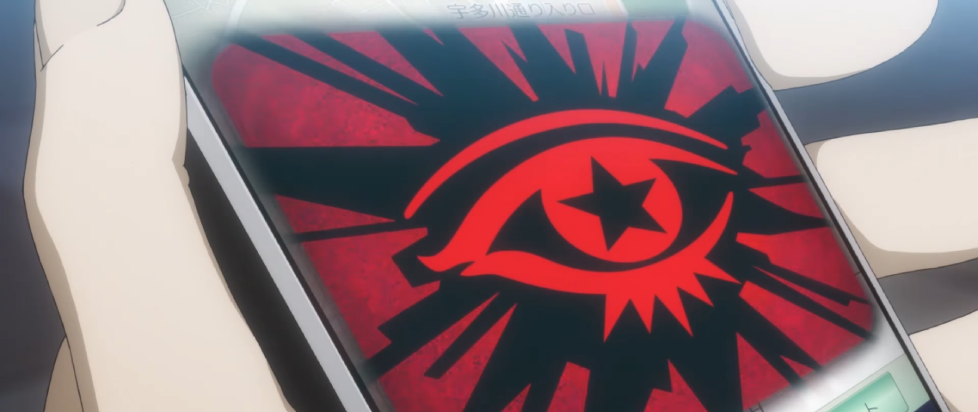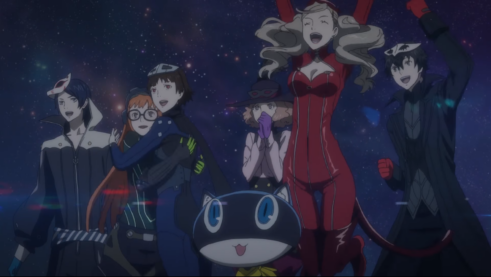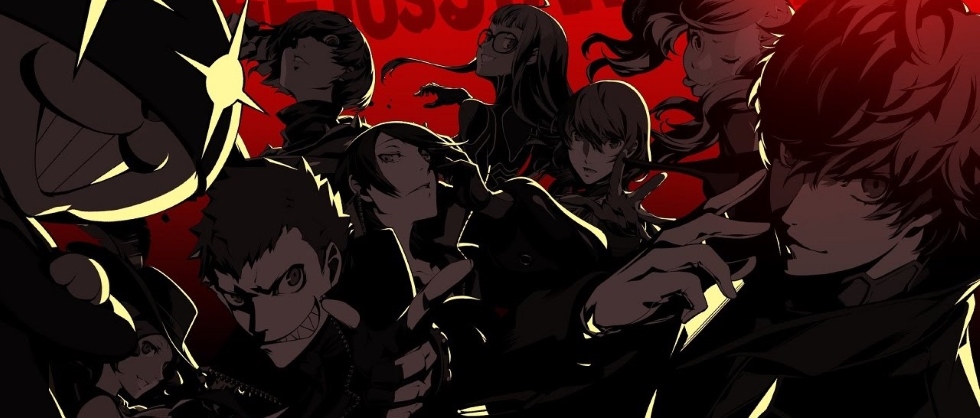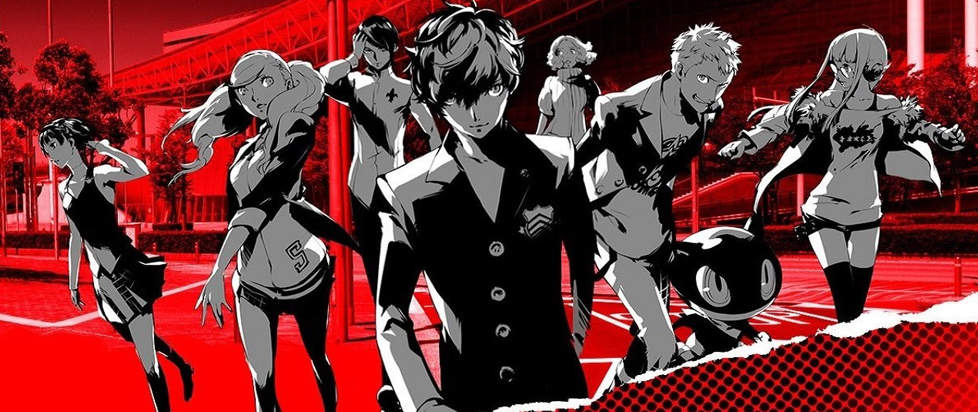
Persona 5: Technology and The Body – Through The Looking Glass
In Persona 5, the main character Joker frowns at a mysterious app that’s suddenly popped up on his phone. The app is a red and black eye, with a star as the pupil. He shrugs it off – but little does he know, that app, the Metaverse Navigator, and his phone become a portal.
Persona 5, developed by Atlus, initially was released in 2016, with an extended edition Persona 5 Royal issued in 2020. The game begins with Joker transferring to a high school in Tokyo after committing a crime, something his fellow students view with suspicion. Amid swirling rumors and hushed whispers around a sinister volleyball teacher, Joker and his new acquaintance Ryuji Sakamoto – another student with a “bad” reputation – stumble upon an eerie castle. By sheer luck, the Metaverse Navigator app takes them to the Metaverse, a “realm of cognition” – where people’s desires and thoughts take shape. It’s also where Joker and Sakamato awaken their Personas and gain powers to defeat the demons skulking around.
This beginning lays out the basic format for the first half of the game: Joker gains allies, identifies corrupt individuals, enters into these individual’s palaces in the Metaverse, and steals the Treasure of corrupt people who have abused others and committed crimes. After their Treasures are stolen, villains experience and express remorse for what they’ve done.
To enter the Metaverse, Joker and his friends need three keywords: the target’s name, location, and how the target views the distortion. And of course, they need the suspicious Meta-Navigation app to verify their answers and transport them into the Metaverse. The phones then are portals to the land of cognition – where desires are amplified, where Joker and his allies shed mortal limitations and gain otherworldly abilities. In this way, the Metaverse can be read as a metaphor for the way technology amplifies vision, reach, and power.
Joker is more powerful in this alternate facet of reality. With his crew of thieves, he can wrest control away from corrupt adults. His “vision” of events – the truth underlying murky situations – becomes amplified. It’s in the Metaverse that Joker’s new ally, Yusuke Kitagawa, realizes that his abusive mentor Ichiryusai Madarame views him as nothing but exploitable resources, after he sees himself and other ex-pupils as paintings in Madarame’s gallery-like palace. The Metaverse Navigation app symbolically is directly tied to vision. The app’s icon design is an eye – a sign for the way anybody who enters can peer further and deeper.

In this Metaverse, everybody’s vision, reach, and abilities are transformed. Augmented by technology, we can do more, see further, and go beyond the human’s physical limitations. It’s exhilarating and indeed, the first half of Persona 5 mirrors this fun by tossing adventures at players. Joker and his allies take down multiple “corrupt individuals,” all by stealing treasures. It’s playful, gleeful, and the player also gets to exercise their newfound powers in the Metaverse by controlling a party of four characters.
But starting near the halfway point, as the Phantom Thieves’ exploits become more daring and as they accumulate a growing adoring fan base – changing people’s hearts begins to feel uncomfortable. Is changing someone’s heart by stealing their treasure really right? Is becoming the Phantom Thieves, stealing into people’s Palaces, and shaping their desires against their will really as easy, fun, and uncomplicated as it has been so far?
As their targets get larger, The Phantom Thieves start to realize the magnitude of the power they have. They can see true desires, change anybody’s heart, and cause an irreversible cognitive change in the Palace owners’ minds. For now, The Phantom Thieves are using their abilities in a just manner – but the question of how long will that last and how the group can maintain that attitude lingers.
Persona 5 is skeptical, perhaps even cynical, about the relationship between Joker and the Metaverse – and the way we desire for more transparent power through technology. Augmentation of our abilities, expansion of reach – all of it comes with uncontemplated consequences, as Joker comes to realize.
In a pivotal moment, Joker and the crew realize the masses no longer want to achieve the same justice the Phantom Thieves do – but instead want an unquestionable leader to dole out punishment.
The God of Control Yaldabaoth, who has been masquerading as Igor, officially enters the stage as the puppet master behind the events thus far. Yaldabaoth is the culmination of humanity’s desire to be ruled over and is the entity that installed Meta-Nav on both Joker and his opponent-slash-friend Goro Akechi’s phone. The Phantom Thieves challenge Yaldabaoth in order to save humanity, and Yaldabaoth in turn, merges the Metaverse – specifically, Mementos – and reality.
Mementos is where the cognitive desires of the masses get squished into one location. It’s like a network of nodes, if the nodes are the inner desires of people. And Yaldaboath is birthed from that network to become what I can only call a God of our own desires to merge seamlessly with algorithms, for the circuitry in our keyboards to become veins, to integrate the rhythm of scrolling into our own heartbeat. Yaldaboath’s promise is seductive. You no longer are separated from others by a screen. You can become even more connected. Your reach can be extended so far that it is no longer yours – it is simply everybody’s. And everybody’s reach is yours. You see everything. There are no barriers. The end point of technology is here: No more barriers, no more restrictions, and no more opaqueness. Pure transparency. The human body is left behind. It’s too restrictive.

Yaldaboath literally takes his final form as a metallic angel. He glimmers like countless shining screens and has no face. His voice is electronic. He has no need for a face nor identity. He’s all metal, all slick exterior – this is the salvation he promises.
In the end, Joker and his friends defeat Yaldaboath through mankind’s rejection of Yaldaboath’s promise via Joker’s Persona, Arsene – who evolves into Satanael. (Yes, the biblical implications aren’t very subtle here.) Mementos and the Metaverse end up getting destroyed.
The original Persona 5‘s “good ending” ends shortly after here, and Persona 5 Royal goes onto a third semester arc with a different “true ending.” For brevity’s sake, we won’t talk about the final “true ending” in P5R.
Even though the “good ending” of the original Persona 5 game literally cuts off the connection between Metaverse and humans – it’s too simple to say that Persona 5 is completely cynical about the Metaverse and its promises of seeing hearts and treasures. After all, if Persona 5 takes a completely anti-technology stance, then its identity as a “game,” a unique electronic media format that can only be experienced with technology, would be awkward.
Persona 5, through unique gameplay sections, celebrates aspects of postmodernity that Frederic Jameson critiques. Jameson’s original postmodern critique (loosely captured here) is that everything has become flat, empty, fragmented, and divorced from a singular linear and historical narrative. While Jameson considers the fragmentation of narratives to be a net negative, other scholars like Jean-Francois Lyotard argue that such new fragmentations in narrative can offer potential escapes from oppressive ones.
This is a viewpoint Persona 5 agrees with. “The whole world is a product of cognition, not just the Metaverse. It can be freely re-made…The same goes for you, and everyone else,” says Morgana. “Soon a new world will come. One where mankind isn’t held captive. The world will shine brightly as long as you hold hope in your hearts. Remember…There’s no such thing as the ‘real’ world. What each person sees and feels, those are what shape reality.”
Persona 5 denies that a fragmented narrative – or a reality shaped by multiple points of subjectivity – is something we should live in fear of. There’s opportunity there, as Morgana points out. Reality then becomes not set in stone, but ever-shifting and always full of potential to be affected by human thoughts, willpower, and social links.

We should not long for a return to iron-clad arcs of historical narratives – something that the metallic god Yaldabaoth also represents, in addition to humanity’s ambitions for technological transmutations, Persona 5 argues. We should reject the desire for firm rules, singular stories.
In a meta way, the very format of Persona 5 believes in that ethos. Fragmented narratives is what a JRPG offers. You can shape your own gameplay experience – in what endings you achieve, what Confidants you rank up, what side activities you go after, and do multiple playthroughs with different outcomes.
Persona 5 falls under the umbrella of the contemporary media technology that Jameson critiques for lacking depth and being able to only signify emptiness – but this is something the game also playfully rejects. In a particularly delightful segment in Madarame’s palace, players get warped into a set of paintings and need to solve puzzles. You, now part of the paintings, soon realize that you can travel in-between different paintings in a linear way. This means you can only move backwards and forwards into paintings. But in a lovely, trickster-way, you discover you can travel backwards and forwards in certain paintings – meaning the paintings now have depth that you can see and experience, something entirely unexpected from what just look like static images.
Perhaps it’s too literal of a reading, but what once was a flat object in the game opens up. There’s depth, if you so chose to play.
———
Writer & dress-up game enthusiast. You can find me on Twitter at @sammyd33d.





